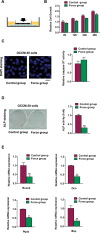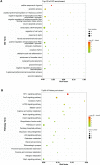Long noncoding RNA expression profile of mouse cementoblasts under compressive force
- PMID: 30605018
- PMCID: PMC8117699
- DOI: 10.2319/061118-438.1
Long noncoding RNA expression profile of mouse cementoblasts under compressive force
Abstract
Objectives: To investigate the long noncoding RNA (lncRNA) expression profile of cementoblasts under compressive force.
Materials and methods: Mouse cementoblasts were exposed to compression (1.5 g/cm2) for 8 hours. RNA sequencing (RNA-seq) was performed to compare the transcriptomes of the compressed and control cells. Quantitative real-time polymerase chain reaction (qRT-PCR) was used to validate five of the differentially expressed lncRNAs of interest. Gene Ontology (GO) functional annotation and Kyoto Encyclopedia of Genes and Genomes (KEGG) pathway analyses were also performed.
Results: A total of 70 lncRNAs and 521 mRNAs were differentially regulated in cementoblasts subjected to compressive loading. Among the differentially expressed lncRNAs, 57 were upregulated and 13 downregulated. The expression levels of the five selected lncRNAs (Prkcz2, Hklos, Trp53cor1, Gdap10, and Ak312-ps) were validated by qRT-PCR and consistent with the RNA-seq results. GO functional annotation demonstrated upregulation of genes associated with cellular response to hypoxia and apoptotic processes during compressive loading. KEGG analysis identified the crucial pathways involving the hypoxia-inducing factor-1α, forkhead box O, and mammalian target of rapamycin signaling pathways.
Conclusions: Mechanical compression changes the lncRNA expression profile of cementoblasts, providing important references for further investigation into the role and regulation of lncRNAs in compressed cementoblasts and root resorption during orthodontic treatment.
Keywords: Cementoblasts; Compressive stress; Long noncoding RNA; RNA-seq; Root resorption.
Figures





References
-
- Diercke K, Kohl A, Lux CJ, Erber R. Compression of human primary cementoblasts leads to apoptosis: a possible cause of dental root resorption? J Orofac Orthop. 2014;75:430–445. - PubMed
-
- Huang L, Meng Y, Ren A, Han X, Bai D, Bao L. Response of cementoblast-like cells to mechanical tensile or compressive stress at physiological levels in vitro. Mol Biol Rep. 2009;36:1741–1748. - PubMed
-
- Diercke K, König A, Kohl A, Lux CJ, Erber R. Human primary cementoblasts respond to combined IL-1β stimulation and compression with an impaired BSP and CEMP-1 expression. Eur J Cell Biol. 2012;91:402–412. - PubMed
-
- Matsunaga K, Ito C, Nakakogawa K, et al. Response to light compressive force in human cementoblasts in vitro. Biomed Res. 2016;37:293–298. - PubMed
Publication types
MeSH terms
Substances
LinkOut - more resources
Full Text Sources
Other Literature Sources

